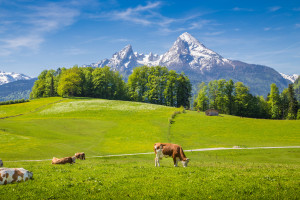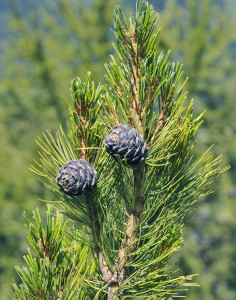The European Alps—stretching from France, Italy, and Switzerland through Germany and Austria and Slovenia—contain within them a diverse series of ecosystems. These include the Alpine lowlands—rich with deciduous trees and ideal for farming and vineyards. Higher up, the area is known for conifer forests of fir, spruce, and pine. Above the tree line, the valleys explode with the plants of the Alpine meadows: herbs, grasses, wildflowers, and shrubs.
The bounty of the Alps is reflected in the wine, food, and spirits of the region. These include:
- Absinthe: The first-ever Absinthe Distillery was opened in 1797 by Henri-Louis Pernod in the Swiss town of Couvet [now part of Val-de-Travers])
- Vermouth: The town of Chambéry, located in the Alps of Eastern France, has long been a center of vermouth production and is now home to several brands of vermouth including Dolin, Routin, and C. Cosmoz.
- The wines of the Alps, which include those produced in the French regions of Jura and Savoie and Italy’s Val d’Aosta.
- The wines of Switzerland, which include some fascinatingly obscure wines produced from the native grapes of region—such as Chasselas, Amigne of Vétroz, and Cornalin du Valais.
- Botanical liqueurs: A range of fascinating and historic botanical liqueurs that includes Chartreuse, Génépy des Alpes, and Bonal.
- Cheese: The legendary dairy farms of the Alps produce a range of cheeses that includes Emmental, Gruyère, Appenzeller, Comté, Abondance, and Fontina Val D’Aosta (as well as fondue and raclette).
And then there’s Zirbenz, known as the Stone Pine Liqueur of the Alps. Zirbenz is a sweet, slightly bitter, fruity, and resinous liqueur flavored with the immature fruit (cones) of the Zirbelkiefer tree (also known as the Arolla Stone Pine Tree). The Arolla Stone Pine grows in the Alps and Carpathian Mountains of central Europe, and can thrive at elevations up to 2,300 meters (7,500 ft) above sea level.
Zirbenz is produced at the Josef Hofer Distillery in Steiermark (Styria), Austria. After the unopened (immature) cones of the trees are harvested, they are sliced open and macerated in a base spirit. This provides the liqueur with its natural earthy-red color and its slightly bitter, tannic finish. It’s something you have to experience to believe.
References/for further learning:

